![]() 1st Battalion 22nd Infantry
1st Battalion 22nd Infantry ![]()
Night Ambush Patrols Tuy Hoa 1971
We conducted our very first
patrol in the rice paddies in January 1971. Lieutenant Rosine was
in charge of it and the patrol
consisted of the entire platoon. The Lieutenant directed me to
walk point and bring the platoon out into the rice paddies. I was
upset.
I had walked point out in the jungle when we were on search and
destroy back in September-October and since then I had been
promoted to Sergeant. I felt I had done my part doing that
dangerous job and now it was someone else’s turn. Besides, I
was now
a Sergeant and could delegate that job to someone of lesser rank.
The Lieutenant calmly explained
to me that we had not been on an offensive operation since
October and that had been in the jungle
which we had become accustomed to and knew quite well. We were
now in open rice paddies with populated areas around and this
was new to us. We had just received a large batch of
replacements, many of whom were fresh from the States with no
combat experience.
He said that it was a good idea to have someone with experience
out in front to make sure we didn’t walk into an ambush or
booby trap
or even step on a mine. That last part didn’t make me feel
good but even though I was mad I had to admit he was right. Phil
Rosine
was a good officer and a great leader. Everything he said and did
always made good tactical sense and was just plain good common
sense.
I took us out into the paddies
and we immediately came upon some old ruins near which was a
flock of ducks. There was a wisp
of white smoke coming up out of the ruins but we couldn’t
see who or what was in there. I cautiously made my way around the
side
of the ruins while Lieutenant Rosine directed half the column
around the other side. As his column and mine got up to the ruins
I turned the corner and came face to face with an old Vietnamese
man and a young girl of about nine who were cooking over a small
fire.
It was their flock of ducks in the paddy and I was glad I
hesitated instead of shooting.
Lieutenant Rosine was right in
that this was a new experience for us. Out in the jungle anything
that moved was either the enemy
or a wild animal so we had to be fast on the trigger. Here we had
to exercise caution. We got used to this new environment very
quickly
but at first it was quite alien to us. We operated in the platoon
sized patrols for only a short time before someone decided it
made
more sense to spread out into smaller patrols which thereby meant
we could cover a larger area.
The Lieutenant continued to
insist I walk point and my anger quickly subsided as I had to
agree he was right to have me do so.
It even became a matter where I felt safer with me walking point
as I didn’t have to worry if someone else was doing it
right.
That may sound conceited but it was not. It was
self-preservation. I walked point on nearly every patrol I went
on until near
the end when I relented to Private First Class Bill Crane who had
been constantly asking me to let him take the job.
When we settled down into operating the smaller sized patrols we quickly developed a routine.
Once a patrol was dropped off
along the road it made its way into the rice paddies and stopped
near its final location,
determining that location by line of sight but not actually going
to it. The final location was picked to cover a section of a road
or rice paddy dike which the enemy might come walking down. The
patrol waited for darkness then moved out to that final spot.
That way if someone were watching this last movement might
confuse them as to the patrol’s exact location.
A trip wire attached to a trip
flare would be strung across the road or dike in the kill zone.
In the jungle such wires and flares
could be tied directly to a tree or bush but in the rice paddies
no such vegetation usually existed. Therefore a trip flare was
wired
to a stick or tent peg and stuck into the ground with the trip
wire from it running across the road or dike to another stick
or tent peg to secure it.
An M-18 Claymore Anti-personnel
mine would be set up to cover the ambush kill zone. The mine
would normally not be set up
directly on the road or dike but off to the side and aimed in
such a way as to fire down the road or dike at an angle thus
covering
a larger area.
The ambush personnel would also
be arranged to cover a maximum area. Often the patrol could be
laid out behind a dike
running parallel to the dike or road containing the kill zone
which would thus give the patrol at least some
rudimentary cover.
The idea was for the enemy to
come walking into the kill zone where the first enemy soldier
would trip the trip wire setting off
the trip flare thereby illuminating the area and the enemy force.
We would detonate our claymore mine which would be the signal
for the patrol to open fire.
That was the way it was intended
to work. On none of the patrols I was on did the scenario go
exactly like that. Half of the patrols
I was on were completely uneventful and turned out to be a case
of lying in the muck of the rice paddies all night long staring
up
at the stars and thinking of home. The other half contained
events that either directly or indirectly affected the patrol to
make it
a tense night for us. No patrol I was on ended up with the enemy
walking into our ambush and us fighting it out with them though
such a scene did happen to other patrols while I was there.
A normal night ambush patrol
would begin with our platoon gathered together at our barracks at
around 4:00 p.m. for a briefing.
The platoon Sergeant would list the names of men assigned to each
patrol and point out on a map board approximately where
each patrol would go. Any enemy activity in the area as reported
by intelligence or reconnaissance would be given to us at that
time
as well as any special instructions such as being assigned to
work with local militia. We would then draw our weapons and
ammunition
from the Company armory and get ready to go. We loaded up on
trucks and left the base in late afternoon or early evening
heading
down Highway 1 and being dropped off at locations near each
designated ambush site. Each patrol moved out into the
countryside
and set up the ambush.
The ambush required us to lie on
the ground all night. Each patrol would work out a guard schedule
to insure that someone
would be awake at any given time. That person would normally
place himself behind the machine gun with the firing device
for the Claymore mine nearby and handy. He would wake up the next
person for his turn. When we first started these patrols
all of us would be awake all night long but as the nights wore on
and we realized that enemy activity was sparse we determined
it was better to alternate guard watch rather than have everyone
fighting to stay awake and possibly nodding off on those nights
when things were quiet and boring.
Half the time we were all awake
all night long anyway. At the pre-patrol briefing we would
sometimes be informed that
enemy activity was anticipated which would move us to caution and
prevent us from sleeping. Or while on the ambush any
commotion in the area such as gunfire or a firefight would have
us instantly awake and alert for the rest of the night. So too
any noises we heard or movement we detected near us would cause
everyone to remain awake from that point on. I can remember
a couple of times when we detected someone or a few persons
walking near us but not directly into our ambush and all we could
do
was radio their movement and direction back to Headquarters.
As the night ended and dawn
began to break we would dismantle our flares and Claymores, pick
up the machine gun and head back
to the highway to await the trucks which would come to pick us up
at some time after first light.
|
Left: M49A1 Surface Trip Flare The assembly consists of the
flare in its mounting bracket with a pull pin clip A trip wire was attached to the
pull pin and when the wire was tripped The flare was about five inches tall and weighed about one pound. Photo from the Advanced
System Technologies Group website |
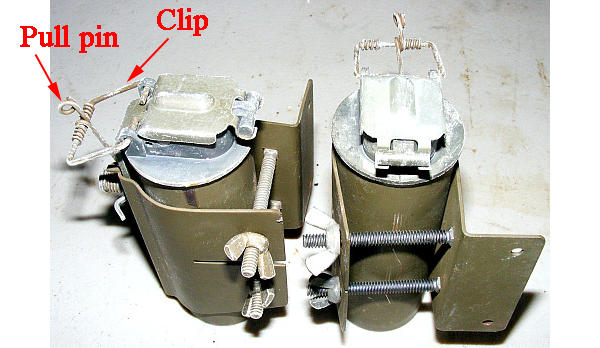
The trip flare showing how
it is securely held in the bracket. For the night ambush patrols
this whole assembly was wired to a stick or tent peg
which was then stuck in the ground. It didn’t need to be
hammered into the dirt. It only needed to be secure enough to
allow the pin of the clip
to be pulled by the trip wire. For operational use the flare was
raised to the top of the bracket with the tip of the firing lever
just clearing the trigger.
The clip was removed and the pull pin part was inserted into
either of the holes to secure the lever. The trip wire was
attached to the loop end
of the pull pin. When the pin was pulled by the trip wire the
lever disengaged and the flare ignited.
When ignited the flare burned with a light intensity of 35,000
candlepower for approximately
one minute.
Photo from the Weaponeer.net
website
Red identifications added by Michael Belis
The M-18 Claymore anti-personnel mine
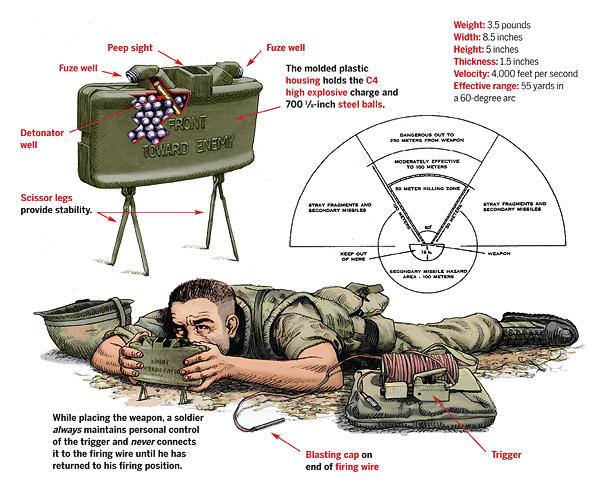
Illustration from the Historynet website
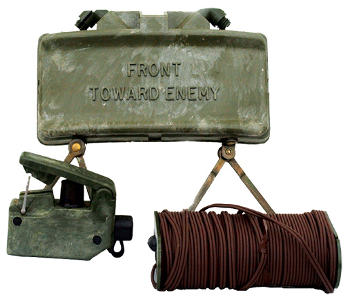
M-18 Claymore
anti-personnel mine – on the left is the firing device or
trigger.
This weapon had a killing zone of about 50 meters in a 60 degree
arc.
Photo from the U.S. Air Force
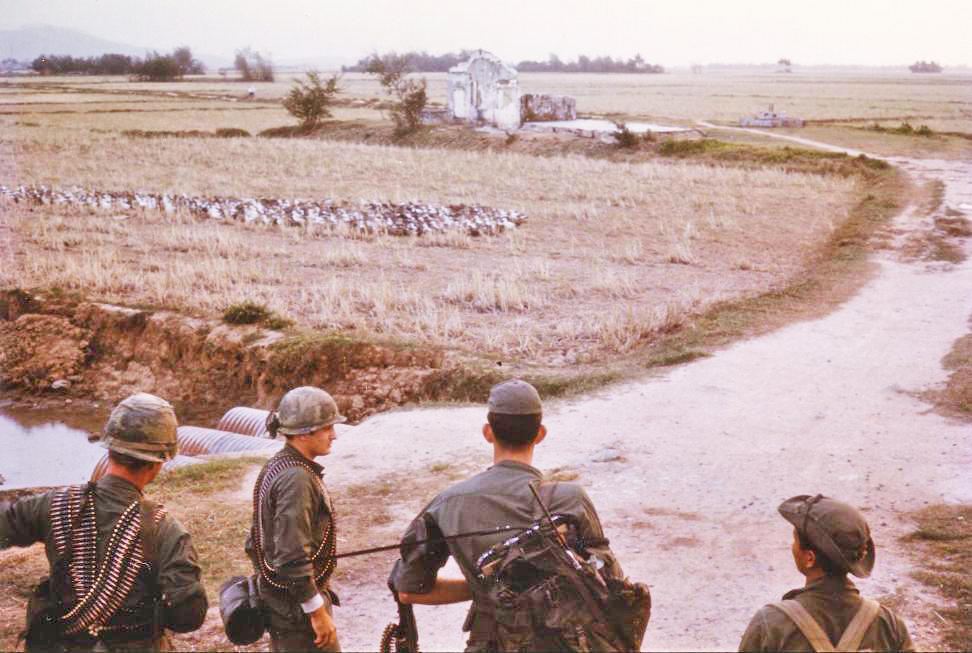
Patrol from either 1st or 2nd Platoon of Charlie Company about to
move out into the rice paddies on night ambush patrol in the area
around
Tuy Hòa 1971. Second from the left is a machine gunner with his
M-60 machine gun in front of him standing nose down on its bipod.
I don’t know
this machine gunner’s name but I remember talking with him
several times. He was a nice guy and had come to us in either
December or January
from another unit which had gone home. He still had time left on
his tour and was therefore sent to us as a replacement. While
with that other unit
he had been wounded in the shoulder and had an impressive scar to
show for it. On another patrol in this same area (after the one
in this photo)
the truck he was riding in either while going out or coming back
in was attacked by the enemy with an RPG or Rocket Propelled
Grenade
(which in Vietnam we called a B-40 rocket.) He was wounded again,
this time by shrapnel which hit him in his back. Third from the
left the guy
with the fatigue cap is carrying a rucksack on its frame into
which he has stuffed the AN/PRC-25 patrol radio. The whip antenna
of the radio
can be seen sticking out of the rucksack and folded to the left.
On the far right is a Kit Carson Scout. Multi-colored blob in
rice paddy in left center
is actually a flock of ducks which was being tended to by a
couple of civilians. The very first patrol I went on in the rice
paddies went right here
and an old farmer and his granddaughter were in that ruin at the
top of the photo. Smoke from their cooking fire was coming up out
of the ruin.
We had never met them before, didn’t know they were there,
couldn’t see them and until we did they had us worried they
might be enemy soldiers.
After being in the jungle for a long time working in a populated
area was a new experience for us.
We got accustomed to this new environment quickly however.
Photo by Michael Belis
In the morning upon returning to
the base after a patrol we could go to the mess hall to get
breakfast. This base we had taken over
from the Air Force had a stateside type of mess hall and
obviously was still in the supply channels where it could get
real food
like we Infantrymen hardly saw in Vietnam. Often the truck would
bring us straight to the mess hall from the ambush and we would
go down the chow line with loaded weapons and ammo which would
cause unfavorable reaction from some of the rear echelon types.
On more than one occasion some person of lesser authority who
thought he was important would confront us about breaking the
rules
of bringing weapons into the mess hall only to be met with
threatening stares from young Infantrymen who were tired, pissed,
hungry
and dangerously armed. Usually a few words of explanation from
one of us would be enough to send the interloper back to his
table
where he could complain to himself.
One morning after laying in the
mud all night I was in the chow line with my rifle slung from my
shoulder and my bandoleers of magazines
strapped all across me. A cook had a crate of eggs and asked me
how I would like my eggs. Being an Infantryman I had not seen
a real egg in so many months I forgot what they looked like. I
responded “anyway you want to cook them” which I
thought told the guy
how much I was looking forward to eating fresh eggs that were not
dehydrated and powdered. He took this as some kind of affront and
commenced to scream at me something about that he had asked me
simply how I wanted them cooked and why was I giving him such
a hard time and some other diatribe that showed how angry he was.
I was too tired to argue with him but decided that I needed to
show
this rear echelon clown that those of us who laid in the rice
paddies all night long to protect his ass did not appreciate
being messed with.
I unslung my rifle while the cook was screaming something like he
didn’t care if I killed him. One of his buddies quickly
shuffled him
out of the way while another cook asked me if hard cooked eggs
were okay. I slung my rifle back over my shoulder and I said
“sure.”
The cook then explained that this other cook’s father had
died and he was denied leave to go home since the funeral had
already occurred
and that was why he was so upset. The next time I was in the mess
hall and that cook who had been so upset asked me how I wanted my
eggs
I told him over easy. He didn’t seem to remember me and was
just as pleasant as could be. I understood that we were all in
this unhappy
situation together and there was no point in taking it out on one
another.
We could either go to breakfast
first and then back to the barracks or go straight to the Company
area directly from the patrol.
After turning in our weapons and ammo we were free until about
four in the afternoon when we would have our platoon briefing
and told whether that night we would go on patrol or guard duty
or have the night off. So after returning to the barracks in the
morning most of us would hit our bunks and go to sleep for a few
hours. This existence went on from January through March
when the Company was then sent into the interior of the country
for a Search and Clear mission in the mountains around Firebase
LZ Action between An Khê and Pleiku.
At least two patrols I was on
were assigned to work with the local militia, the
“Ruff-Puff’s.” On one patrol we joined about
fifteen
South Vietnamese who were dressed in a mixture of uniforms and
civilian clothes and who were armed with a variety of weaponry
ranging from World War II M-1 rifles and carbines, BAR automatic
rifles to a few M-16 rifles. We all moved to the outskirts of a
small village that was about a mile from the highway and we lay
behind a couple of rice paddy dikes facing toward the west
covering
a road that ran through the paddies connecting this village to
the next. Our patrol was awake all night but we suspected the
South Vietnamese
(who were behind us along a dike positioned to our rear and off
to our side) went to sleep leaving us to do the work of remaining
alert
in the ambush.
On another patrol assigned to
work with the militia we went into a village situated close to
the highway. The head of the local militia unit
got into a heated argument with our platoon sergeant as to what
the duties of the night’s patrol was to be about. Though
there were difficulties
in the language barrier between the two it was apparent that our
leader expected us all to set up the ambush together in the area
outside
the village as he had been directed to do while the militia
leader wanted us Americans to remain in the village while his
people took care
of the ambush outside the village. The confrontation resulted in
a mutual case of distrust and dislike between we Americans and
the
Vietnamese and the situation was tense for a while as both sides
readied themselves should the scene go violent. The situation was
resolved
when our platoon sergeant and I discussed the possibility that
these Vietnamese could be enemy sympathizers or perhaps there
might be
some activity going on that night they did not want us to observe
for some reason. We determined it was best to do things the way
the
Vietnamese wanted. Our patrol remained in the central courtyard
of the village while most of the militia left the area,
presumably to go
set up the ambush outside the village. We spent the night uneasy
huddled on the ground against a building in the courtyard with
most of us
staying awake and two or three of the militia in the courtyard
near us through the night. In the morning the militia leader
appeared and
we bid our goodbyes in a somewhat amicable fashion as we walked
back to the highway to await our truck.
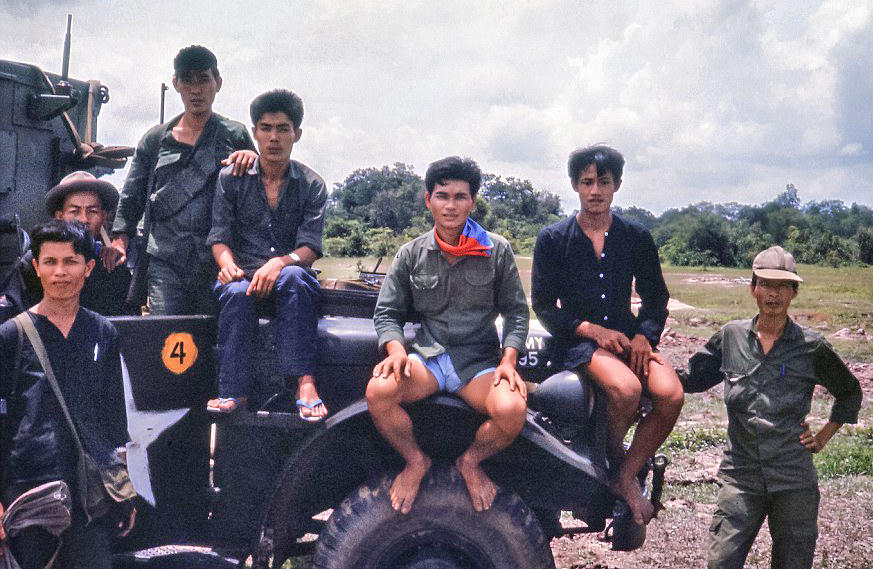
South Vietnamese Regional Force/Popular Force militia dressed in
a mixture of uniforms and civilian clothes. The soldier in the
truck
is armed with a WWII era M-1 carbine. The "Ruff-Puffs"
we worked with looked a lot like these guys.
Photo by Christopher Gaynor from the Daily Mail website
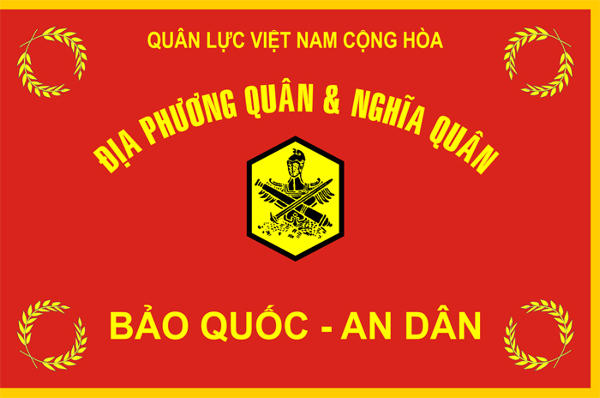
South Vietnamese Regional Force/Popular Force flag
On one patrol we covered a
section of a low levee (only one or two feet high) which ran from
the highway westward toward the
mountains. We set ourselves behind a paddy dike to the north of
the levee and running perpendicular to it facing down the levee
looking west. On the south side of the levee and running parallel
to it was a deep irrigation ditch. On the other side of the ditch
was a dirt pathway wide enough for a cart which also ran parallel
to the levee. At this time of year the sluice gate to the ditch
was closed
so the ditch was empty of water and dry. That ditch was seven or
eight feet deep and around fifteen to twenty feet across. We
stretched
a trip wire attached to a trip flare across the levee, another
across the bottom of the ditch and one more across the cart path.
We set up a Claymore mine to cover the levee, one to cover the
cart path and another Claymore down in the ditch.
Sometime during the night the
trip flare in the ditch ignited. Lying down in the paddy we
couldn’t see into the ditch but the glare
from the flare did give enough light to see down the levee and
the cart path a ways and no one could be seen on either.
We detonated the Claymore in the ditch and waited while the flare
burned itself out. We spent the rest of the night with our
fingers on our triggers but saw and heard nothing else.
As the dawn broke and there was
enough dim light to see, Spanky Sullivan and I crawled on our
bellies across the levee toward
the ditch about 30 or 40 feet apart from each other. As we got
near to the edge of the ditch we looked at each other and I
signaled
with my fingers one, two, three and we both leaned over the edge
with our rifles pointed into the ditch. Lying dead in the bottom
of the ditch was a brown dog about forty pounds in size. Poor guy
had come trotting down that ditch, tripped the wire and set off
the flare. We sent him to doggy heaven when we blew the Claymore.
One of the guys in the patrol said he must have been an
enemy Viet Cong bad guy dog because if he’d been a good guy
dog he would have known not to be out after curfew.
One night another patrol from
our Company about a mile away from the one I was on got into a
fight with the enemy.
We couldn’t see the gunfire but the atmospherics were right
and we could hear some of it across the open paddies.
And we could see some flashes from explosions. It went on
furiously for a while and then stopped. A bit later it began
again
and lasted for another few minutes. A short while after that the
guy monitoring our radio said a helicopter gunship was taking off
from Tuy Hòa to go help.
A few minutes later we watched
the helicopter circle the area of the fight while dropping flares
to illuminate the area. It was a
Huey gunship not a Cobra. A few of us put our ears close to the
radio’s handset and shared listening to the conversation as
the
pilot talked to the patrol on the ground and Headquarters back at
Tuy Hòa. The aircraft made circles and figure eights across the
sky
as it searched for the bad guys. It found them running through
the area heading for the nearby river. We watched as the
helicopter
dived down and saw the red tracers of its machine guns firing
down into the ground.
We heard the pilot say the enemy
was crossing the river as he made a second pass firing all the
way. As he circled above the pilot
related that the enemy had gone into a village on the other side
of the river and requested instructions. It was some time before
Headquarters responded and they told the pilot to fire into the
village. We figured this village was on the list of suspected
enemy
supporters. The pilot continued to circle his aircraft while
repeating several times his request that went something like
“do I read you
correctly that you are ordering me to fire into the
village?” It was obvious he wanted anyone listening to the
radio to know that
Headquarters had ordered him to open fire on the village, that he
had not done so on his own. Once satisfied he had made this
request enough he dived his aircraft and let loose on the village
with machine guns and rockets. He expended his ordnance but
remained on station dropping a flare now and then while looking
for any more evidence of the enemy. After a while he flew back
to Base. All was quiet for the rest of the night and we all
remained awake and alert in case this was part of a larger
operation
by the enemy which might include us.
In the morning we moved back to
the highway and when picked up by our truck were notified we were
not going back to the Base.
The truck brought us south to the same levee where we had killed
the dog on an earlier patrol. Other trucks were parked in the
area
and we moved out along the levee heading west. We found the guys
from our Company down the levee as their patrols had been
brought here as well. We joined them and South Vietnamese
soldiers and militia and stretched out up and down the levee in a
long
formation that covered what looked like a mile or so along it. As
we waited a small party of villagers came down the levee from the
west
with a litter which consisted of a sheet tied to a long pole
being carried by two guys. I walked over to the litter and saw
that inside
the sheet was a person, with blood spotting the sheet. The person
was pretty much covered by the sheet so I couldn’t tell if
it were
man or woman, young or old, soldier or civilian, alive or dead. A
Vietnamese militia officer immediately came over and began
shouting
orders and the two guys carrying the litter and the party of
villagers moved quickly up the levee heading east toward the
highway.
After waiting some more the long line of American and South
Vietnamese soldiers were directed to make a sweep southward
toward the river. A couple hundred soldiers started moving in a
ragged line across the levee, across the irrigation ditch and
through the countryside heading toward the river.
The area where my patrol was
engaged was not rice paddy but rather was open countryside with
sandy soil sparsely dotted with
bushes and areas of mostly waist high tall grass. One of the guys
called me over and I saw that he had found a blood trail going
through the grass. We continued to move through the area
following the blood trail until we got to the river. Upon meeting
the river
the sweep stopped. No bodies or live people had been found though
like my patrol someone else had found a blood trail leading
to the river. After a while we were directed to head back to the
levee, walk back to the trucks and head back to the Base.
The outcome of this episode was left up to someone else.
Sometime later I talked to a
tall black guy who was on that patrol that got into that fight.
He told me the experience was pretty intense
while they shot it out with the enemy. All guys on the patrol
received a medal with a couple of them being slightly wounded.
No Americans were killed that night however.
Our platoon sergeant for 3rd
platoon (my platoon) had led a patrol in the area that night and
I learned that when the shooting started he picked up
his patrol and led them running through the countryside to go to
the aid of the of the patrol that was under attack. He and his
patrol were almost
a mile further away from the beleaguered patrol then my patrol
was. They never made it to the other patrol but stopped and spent
the night
out in the rice paddies.
When I heard that I had mixed
feelings. On one hand it was nice to know he would rush to the
aid of buddies who were in trouble.
But on the other hand I felt it was a bad move to go running
through the countryside at night into an unknown scenario. The
enemy
could have hit that patrol on purpose to draw out reinforcements
who they could then ambush. Or the sergeant could have blindly
stumbled into an American or South Vietnamese ambush patrol in
the dark and get shot up by his own side.
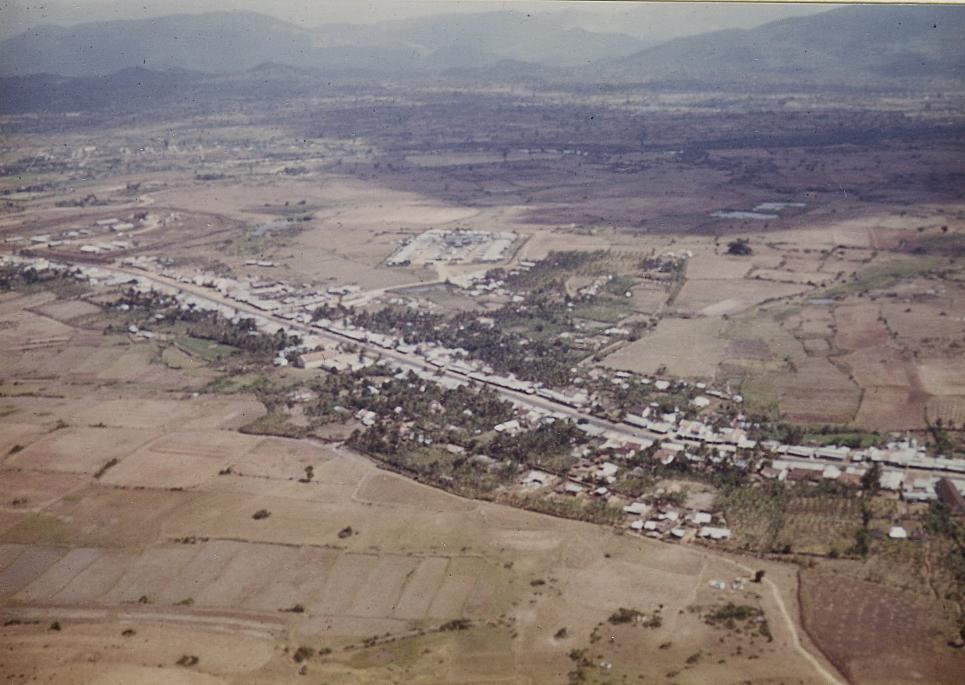
Section of Highway 1 in the area near Tuy Hòa. I believe this is
a bit to the south of our normal patrol range and closer to Phú
Hiêp
and may be the village of Thach Châm which was south of the
Bánh Lái river. Village located near two small South Vietnamese
military
installations (in far left of photo and in upper center just
below shadow of cloud.) Note how many of the houses and buildings
are right
on the highway. Two steps out the front door and you were right
on the asphalt of the road.
Rice paddies on either side of the highway. The mountains can be
seen in the background.
Photo by Michael Belis
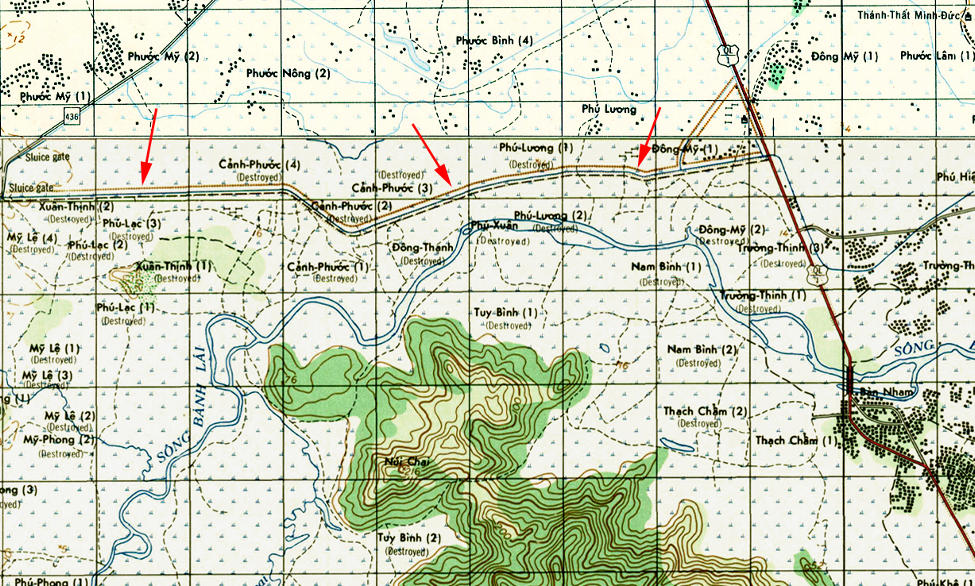
Above: North is to the top. Highway 1 (QL 1) is on the right
marked with the shields. Red arrows point to the brown dotted
line on the map
which is the levee running through the rice paddies from west to
east. Single blue line running parallel to the levee is the
irrigation ditch.
Black dashed line running parallel to that is a cart path. Double
blue line below that to the south is the Bánh Lái river (Sông
Bánh Lái.)
This levee, irrigation
ditch and cart path are where a patrol I was on killed a dog when
he set off one of our trip flares. This is also the place where
after a fight we lined up a couple hundred soldiers or more and
searched for the enemy by moving through the countryside toward
the river.
This location was really
at the southern limit of the range of our night ambush patrols.
Across the river to the south is the tip of a small mountain
range
beginning with the two hundred foot tall hill known as Núi Chai.
Directly to the east of Núi Chai and over on the coast was the
airfield at Phú Hiêp.
This coastal mountain
range extended further south and contained Núi Ðá Bia which
rose to an elevation of over seven hundred feet. The area on the
southern side of the Bánh Lái river came under the
responsibility of the South Koreans who had units stationed at
Phú Hiêp.
The designation
Destroyed under some of the villages does not mean they have been
wiped out. It means that at some time the Vietnamese abandoned
the village or moved it to a different location. For instance
Cành-Phu'òc was moved four times thus it is marked as
Cành-Phu'òc 1, 2, 3 and 4.
Map of Tuy Hòa/ Phú Hiêp area is from two 1:
50,000 maps folded and matched together. Top portion is from grid
map Sheet 6835 II
and bottom portion is an early version of grid map Sheet 6834 I.
Red arrows added by Michael Belis
I was on one patrol with six
other G.I.’s from 3rd Platoon and a Vietnamese Kit Carson
Scout from our 2nd Platoon.
His name was Binh, and though he spoke little English, he was
well liked in our Company. He was typically short in stature
and looked to be in his late twenties or early thirties. He was
serious about working with the Americans and had a good and
trusting
effect on any American he worked with. The Kit Carson Scouts were
former communist soldiers who had surrendered and joined
the South Vietnamese cause. We called them “KC’s.”
As were most of these patrols
this one was uneventful and after laying in the rice paddies all
night long, just before the sun came up
we picked up our machine gun, dismantled our claymore
anti-personnel mine and trip flare and moved out along the rice
paddy dikes.
Our patrol returned to the outskirts of a village along the two
lane blacktop highway in the last moments before dawn to await
pickup
and return back to the base. We moved down the road through the
village until we were nearly all the way to the northern end of
the
village. We stood and waited, half of us on the edge of the road
and half on the ground level porch of a house which itself was
only
about 20 feet from the road when we were fired upon from the
darkness just outside the village. The burst of automatic weapons
fire
smashed into the low roof of the house we were standing in front
of, just missing our heads.
We all hit the dirt and for an
instant no one moved. When we dropped down one guy standing near
me on the edge of the road
scrambled to duck inside the ground level porch of the house and
dropped his rifle. It fell and clattered on the asphalt road
beside me
as I flattened out on my stomach. Our Kit Carson Scout Binh
grabbed the M60 machine gun and began to move in the direction
from which the fire had come. I was immediately up and behind him
and the two of us carefully made our way along the side of the
road
out of the village toward the rice paddies.
I don’t know what went
through Binh’s mind, to make him go after the unseen enemy,
but the reason I joined him was because
I was thinking several things all at once. I figured that if he
had to fire that machine gun the recoil would probably knock his
little frame
backward so I better go with him to put a hand on his back and
hold him up. I also wasn’t happy that one of our new
replacements
had dropped his weapon the moment he was fired upon. My survival
reflex told me not to stay around someone who would do that.
Finally, I didn’t want to stay where I was, in case the
shooter’s next burst might be more accurate and hit us.
With me only a few feet behind
him Binh slowly walked forward slightly bent over with the
machine gun pointed out to his front
and his hand on its trigger. We moved past several houses then
crept along a cement wall which was nearly six feet high and was
the last structure on the edge of the village. I lifted up on my
toes and peered over the wall and saw that it surrounded a
schoolyard.
When I saw the two story plaster sided building that was the
school, for some reason it made me think of the Alamo. The place
where all the defenders died. I suddenly was very aware of how
exposed we were and I thought to myself “what a dumb move
this was…
why didn’t I just stay down on the ground with the rest of
guys?” However, Binh was still going forward, staring
intently into the darkness,
looking for whoever or whatever was out there. Though I no longer
thought this was such a good idea I was compelled to follow this
little guy who was so brave as to take the fight to the bad guys,
rather than just lay there. We continued along the road past the
schoolyard
for another thirty or so meters until we were out of the village
completely and standing in the open with rice paddies to our left
and right.
I instinctively crouched down on one knee and was glad to see
Binh do the same. We scanned the countryside as the darkness
slowly
dissolved into the dim light of the morning dawn.
We took no more fire and after
seeing and detecting nothing we rejoined the rest of the patrol.
Apparently our assailant fired his one try
and took off. It might not have even been the enemy, it could
have been some local with a grudge against Americans. Binh gave
the
machine gun back to its owner and quietly kept to himself. I was
moved to admiration and respect for this former enemy. While the
rest
of us froze, it was our Kit Carson Scout who had reacted quickly
and strongly.
Not all the Kit Carson Scouts
were like Binh. Some didn’t hold our trust and some were
just not good soldiers. We had a couple of them
in 3rd Platoon who we had problems with and who we eventually
refused to work with because they were just about useless to us.
(Myself and Jim Regalia were detailed to return the two of them
back to the Chiêu Hôi center in Saigon on Christmas Eve 1970.)
Most of our night ambush patrols
did not include a Kit Carson Scout. Our Kit Carson Scouts were
assigned to the different Platoons
in our Company and went out on the patrols with us just as any
other member of the Platoon would. But that night, standing along
Highway 1 on the coast of the South China Sea, I felt lucky the
patrol I had been on had a Kit Carson Scout named Binh.
|
Left: Kit Carson Scout Binh
mentioned above. I took this photo See full photo below. Photo by Michael Belis |
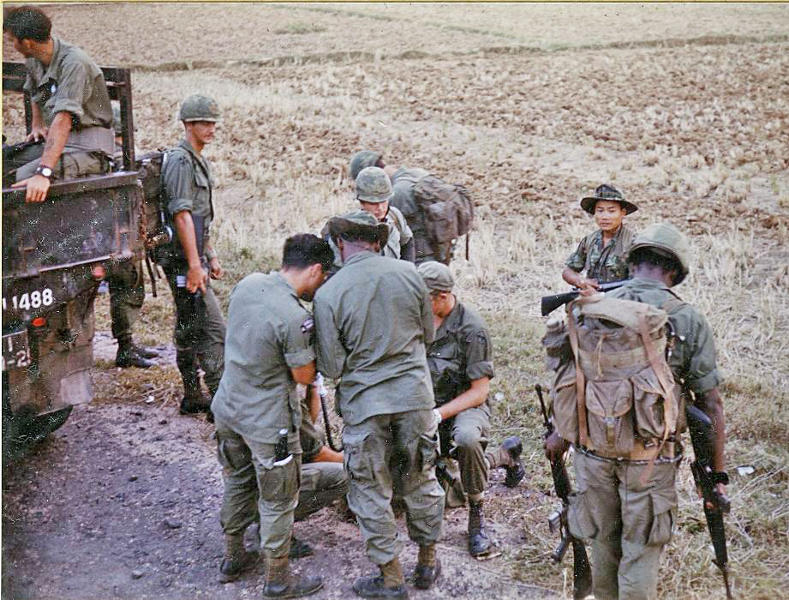
Members of Company C
stopped along Highway 1 on deployment of night ambush patrols
around Tuy Hòa 1971. In the foreground
huddled together reading the map with their backs to the camera
are Specialist 4th Class Mike Hernandez (without a hat and with a
big knife
stuck in the pocket of his trouser leg) and Staff Sergeant
Williams (with the boonie hat.) Kneeling on the ground to the
right of Williams is Utah
our truck driver. At the top far right facing the camera with a
wide brim boonie hat and cradling his rifle is Kit Carson Scout
Binh from 2nd Platoon.
At the end of one
uneventful patrol that I was on with Binh and six other guys, as
we stood along the road just inside the edge of a village
awaiting
pickup just before dawn we took a burst of automatic weapons fire
from the rice paddies just outside the village. The bullets
smashed into the low roof
of a house we were standing in front of just missing our heads.
Binh grabbed our machine gun and I followed behind him as we made
our way
along the road out of the village toward the paddies.
Once we got beyond the
end of the village we stopped and scanned the darkness of the
countryside but we saw and heard nothing and took
no more fire. No one was hurt but it gave us all a good scare.
Photo by Michael Belis
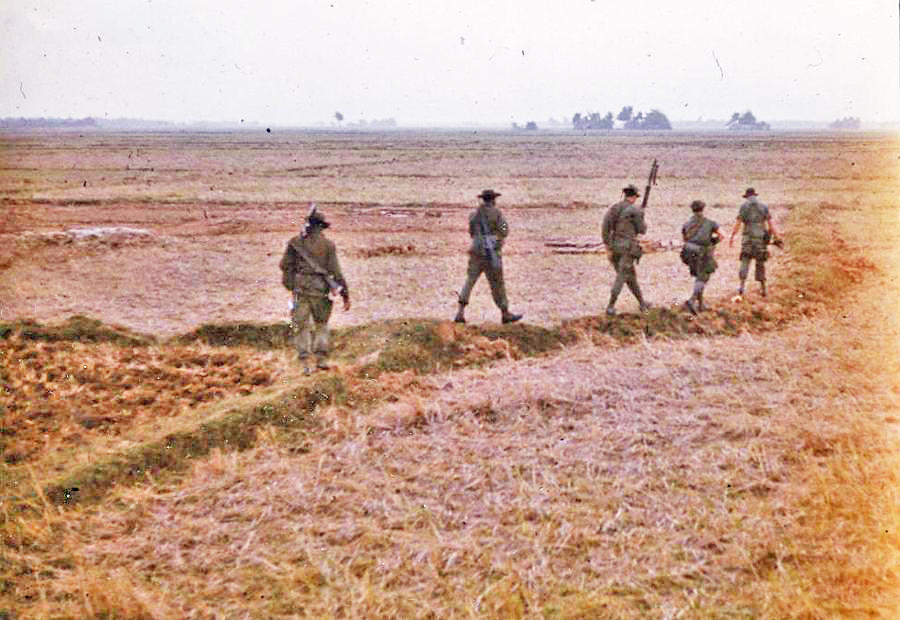
Soldiers from 3rd Platoon Company C 1st Battalion 22nd Infantry
move out into the rice paddies near Tuy Hòa on night ambush
patrol,
early 1971. The machine gunner is in the middle holding his gun
pointed up. Second from the right is Private First Class Bill
Crane. On the far left
is Sylvester Bobo. Bobo carried both an M-16 rifle and an M-79
grenade launcher on these patrols. His grenade launcher can be
seen
slung across his back and his rifle can be seen lazily draped
over his left shoulder. This is not a complete patrol as the
radio man is not in the photo.
He is probably to the left out of the frame. This is the kind of
open rice paddy area as described in the incident related in the
sections below.
Photo by Michael Belis
One night instead of being on
night ambush patrol I was sergeant of the guard for our platoon
as it was on guard duty at the Base
at Tuy Hòa. That night the enemy attacked a South Vietnamese
Army (ARVN) garrison near our Base. From a guard tower on the
north side of our Base I had a front row seat to watch the attack
and even took a couple of photos of the attack in progress.
The next time I went out on night ambush patrol our truck passed
right by that ARVN compound and we were able to view
the results of the attack as we drove by. At least three of the
buildings were burned to the ground. Another building with a
stucco
type exterior had a huge hole in the end of it with the edges of
that hole blackened by smoke. There was a lot of other damage and
debris all over the ARVN compound that showed that the attack had
been pretty intense for whoever was in the garrison at the time.
It was a grim reminder that even though most of our patrols were
uneventful the enemy was still in the area and able to carry out
operations. We always understood that any of the patrols could
turn deadly at any time.
When we first started going out
on these patrols I made sure I carried a Claymore mine with its
firing device and a spool of electrical
wire for it. I also carried a trip flare that I had wired to a
stick while we were out in the jungle back in September-October
and had kept
even after we had been pulled out of the jungle. As time went on
I stopped carrying the Claymore as I found other guys who were
more
than willing to do so but I still carried the trip flare attached
to the stick and another stick to tie the end of the trip wire
to. This assembly
was a work of art and I had constructed it so well it was still
working after many months of usage. Other guys began to imitate
what
I had done with the trip flare and eventually I found I could
stop carrying the flare as well. It made for less of a load I had
to carry
and less duties for me by not having to set it up and take it
down.
Near the end of March I was on a
patrol consisting of either six or seven men altogether. I
don’t remember the number exactly
or the names of who was on the patrol. I was not in charge of the
patrol, there was another sergeant who was one grade above me
in rank. We went way out into the rice paddies and picked a spot
where we could lie behind a small paddy dike and cover another
larger dike running parallel. There weren’t any houses
around in any direction for nearly a mile. We were in open rice
paddies.
As we prepared to set up the
ambush we found that no one had brought a trip flare. I got mad
about that but not at anyone but myself.
I had stopped bringing along my own trip flare out of laziness or
selfishness. But I had also not checked the patrol before we left
the Base to make sure that someone had a flare or even checked to
make sure someone brought a Claymore or any parachute flares.
Someone had brought a Claymore thank goodness but no trip flare
and no parachute flares!
The men assigned to each patrol
were hardly ever the same so it wasn’t a case of the same
guy always carried the Claymore or
the same guy always carried the flare and the flare guy forgot it
this time. It just turned out that no one brought any flares that
night.
Since I was not the leader of this patrol it was technically not
my responsibility to make sure the patrol had everything it
needed.
But as a sergeant I should have taken that load off the patrol
leader and checked to insure the patrol I was on had all it
should.
I usually did exactly that and I was now kicking myself for not
doing it that night. I screwed up.
Without that flare to warn us of
the enemy’s approach we decided that all of us would have to
remain awake throughout the patrol,
just in case. To the credit of the men that night everyone agreed
without a single bit of grumbling. We did not have a night vision
device
with us but the moon was half full and the clouds were reasonably
thin so we had some semblance of visibility.
A little past one in the morning
we heard voices approaching us from the left. Since we were
facing west that meant someone was
coming up from the south. They weren’t talking loudly but
they weren’t whispering either. And it appeared they were
walking along
the dike we were covering and were coming right into our kill
zone.
We all quickly and quietly
checked each other to make sure everyone was awake and alert to
the danger. I was lying to the right
of the machine gunner with the patrol leader a couple of guys
down on the gunner’s left. The machine gunner brought his
gun up
to his shoulder with his finger on the trigger.
I picked up the firing device to
the Claymore mine and made sure the safety clip was in the down
or firing position. Since I held
the firing device it would be my responsibility to initiate the
ambush by detonating the mine. That would be the signal for the
machine gunner and the rest of the guys to open fire.
The voices were coming closer
and we could tell they were speaking in Vietnamese not English.
They were speaking in hushed tones
but still carried loud enough so we could hear them. Something
made me lean over and place my mouth touching the ear of the
machine gunner and I whispered “hold your fire.”
The intruders began to cross
through our kill zone. There was just enough night vision to see
them as dark silhouettes as they passed
before us on the dike opposite us one hundred feet away. The
field of view of our vision in the darkness was limited to about
twenty
feet wide. We could not distinguish uniforms but it was evident
they were carrying weapons though we couldn’t tell what
kind.
About five had walked by when I
began to count them. Only the first couple of them had been the
ones doing the talking.
I stopped counting at twenty-five. At least ten more walked by
after I had stopped counting. That meant there had been forty
or more of them altogether.
I had not blown the Claymore and
the other guys had not opened fire, obviously waiting for the
signal and not shooting since
they had not received that signal to do so. I was incredibly
thankful and proud of the fire discipline of the men I was with
that night. If we had opened fire we would have killed some of
the enemy but not most of them. Strung out as they were
along that dike I don’t think we would have got very many of
them at all. That would have left most of them to return fire at
us.
And with no flares to light them
up for us we would have been firing blindly into the dark at
them. They, on the other hand,
would have known right where we were by the light of our muzzle
flashes and they could have concentrated all their guns on us.
Their initial response could have been devastating to us.
I don’t know what made me
hold our fire that night. Call it a sixth sense, call it fate,
call it God. I certainly can’t explain it.
It was just a feeling I had and as it turned out I was glad I had
it. The enemy had not seen our Claymore because it was off the
dike
and in the paddy and they had not seen us because we were lying
down behind the opposite dike a hundred feet away in the
darkness.
We waited a couple of minutes
until we were sure there were no more coming and then the patrol
leader got on the radio
and called Headquarters and informed them that forty Victor
Charlies (phonetic pronunciation for the letters VC for Viet
Cong)
just passed by our location heading north. By giving our
patrol’s call sign Headquarters would know our location. The
rest of the night
was uneventful but tense as we remained alert until daylight when
we could head back to the Base.
A couple of days later one of
our Lieutenants came up to me as I stood behind our platoon
barracks. He had heard about
the incident of the forty enemy soldiers walking through our
ambush. I think he may have been Lieutenant Trent but can’t
remember
for sure. I do however remember the conversation. In response to
his question of what it was like I related to him the events of
that night.
I told him it was probably a group of ARVN (friendly South
Vietnamese soldiers) and we had been scared for nothing. He told
me
“Sarge I was at the Battalion briefing before the patrols
that night and the Captain specifically asked if there would be
any ARVN patrols,
ambushes or movements in our area of responsibility that night
and the briefer responded that no ARVN activity was scheduled for
that night.”
If I had done my job correctly
that night and made sure we had brought a trip flare and we had
set up that flare like we should have
across that dike the enemy would have walked right into it,
setting it off. We would have had no choice but to initiate the
ambush and
open fire.
Is it possible we could have won
that fight? Maybe. But as outnumbered as we were out in that open
field it’s more likely
we would have got ourselves shot to hell instead.
All the time I had been in this
war I had been working so hard to screw up as little as possible
and yet that night it was a screw up
that quite likely saved our lives. What insanity.
Since I spent nearly all of
April 1971 (my last month in Vietnam) at LZ Buffalo the night
ambush patrols were over for me
by the end of March. My part in them had lasted from January
through March 1971.
I left Vietnam for the United States the first week of May 1971.
Home | Photos | Battles & History | Current |
Rosters & Reports | Medal of Honor | Killed
in Action |
Personnel Locator | Commanders | Station
List | Campaigns |
Honors | Insignia & Memorabilia | 4-42
Artillery | Taps |
What's New | Editorial | Links |